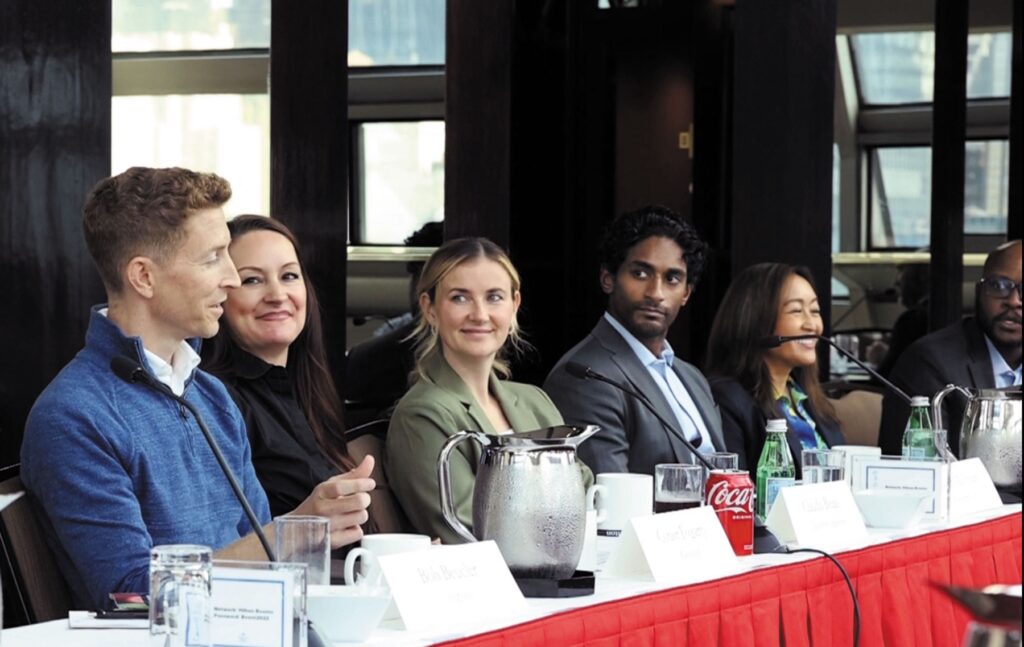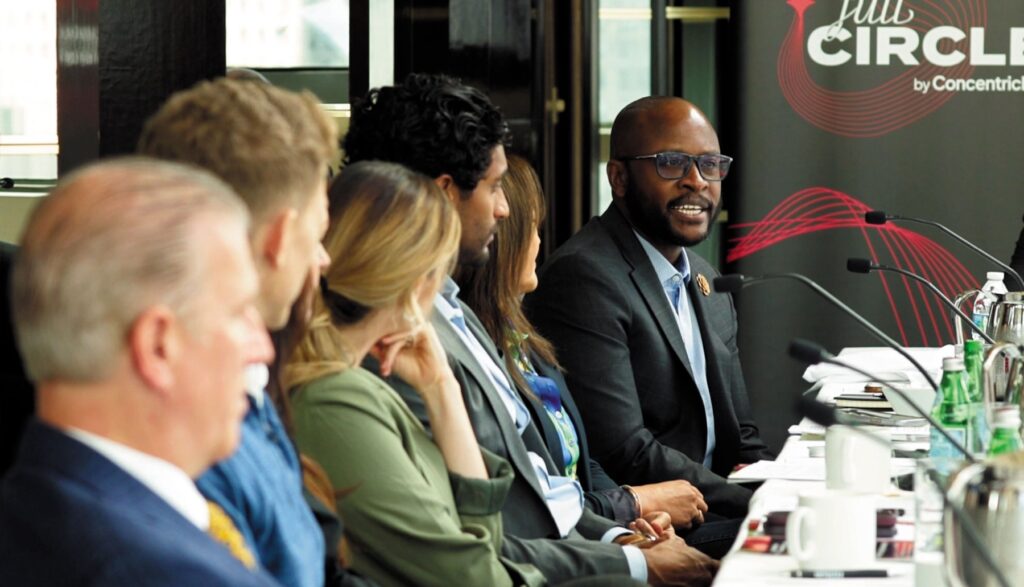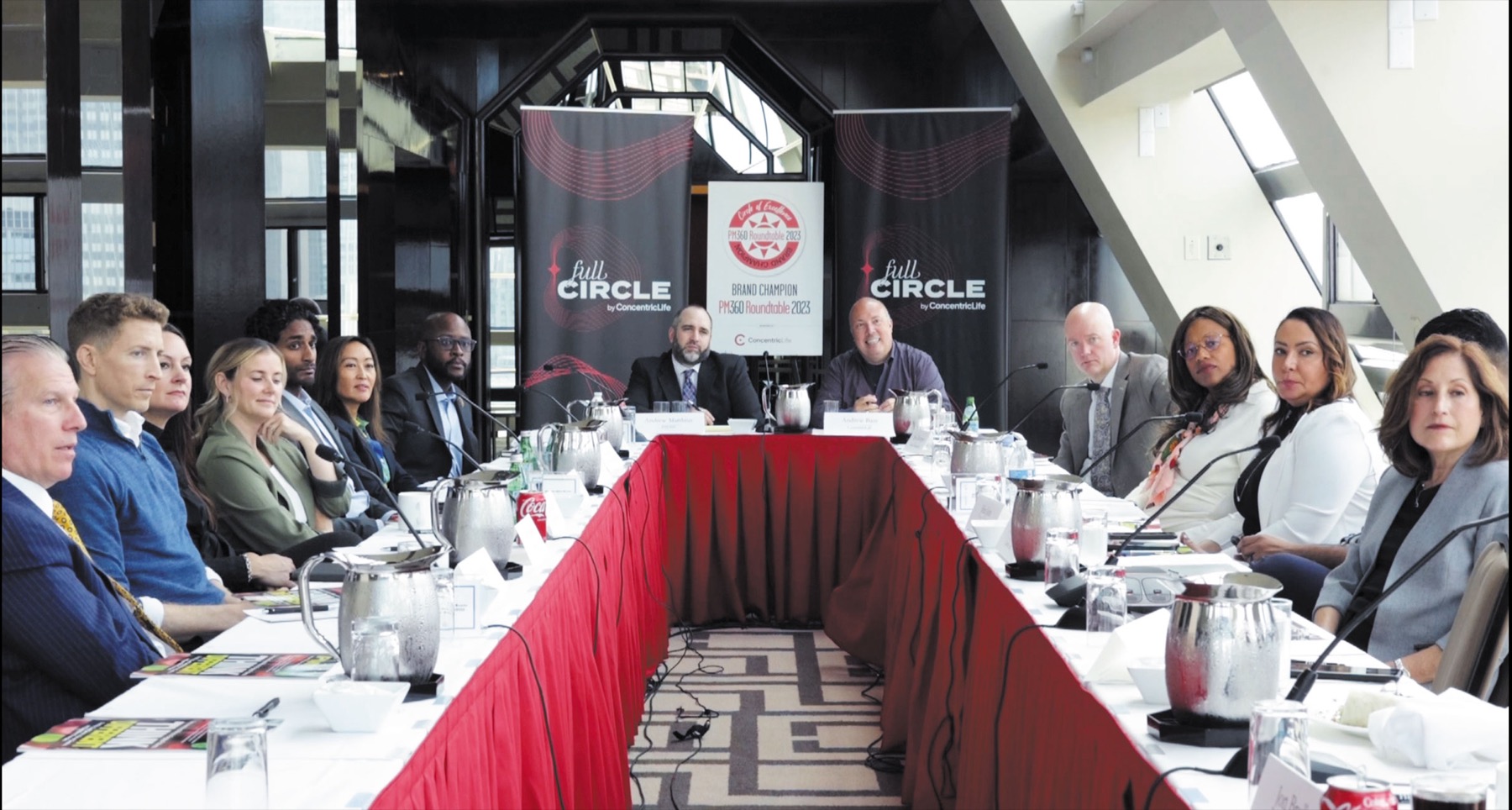Participants gathered in New York City for a discussion on all aspects of the patient experience, including success stories, important benchmarks, first-hand experiences, and offered their expert views on how the industry can thrive now, and moving forward in a rapidly-evolving industry.
On October 2, 2023, we gathered our 2023 Trailblazer Brand Champions and the Marketer of the Year for a roundtable discussion sponsored by ConcentricLife on the current state of the healthcare experience and what healthcare companies can do to meet patient’s raising expectations. The discussion was moderated by Andrew Bast, Chief Strategy Officer, ConcentricLife, and participants included:

Dana Anselmo
Patient Voice Strategy, Engagement & Experience Design, Genentech

Claudia Beqaj
Executive Director, Dermatology, Boehringer Ingelheim

Anna Czene
Vice President, Corporate Communications & DEI Lead, CareDx

Steve Davenport, Senior Director, U.S. Commercial Data Management & Strategy, Takeda Pharmaceuticals

KC Dickerson
EVP Head of Engagement ConcentricLife

Conor Fogarty
Marketing Team Director, Neuroimmunology Franchise, Genentech, Inc.

Katrina Sergeev Gary, Sr. Director US Marketing and Patient Engagement argenx US, Inc.

Lisa GreenDirector, Global Marketing ‑ Rare Diseases Chiesi Global Rare Diseases

Akil Hunte, Director, Patient Empowerment, FILSPARI Marketing Team,
Travere Therapeutics

Jibin John, Sr. Manager, HCP Marketing ‑ Dermatology
Regeneron

Kristin McAteer
Managing Director, Client Solutions, ConcentricLife

Dinesh Vannan, Director, Marketing, Rare Disease Portfolio
Chiesi Global Rare Diseases
Our expert panel discussed how they aim to improve the patient experience, how brands build trust, what we can learn from the world of consumer marketing, and the technology and programs that can best serve an organization’s brand purpose.
Andrew Bast: I’m happy you were able to join us this afternoon for this year’s Trailblazer Circle of Excellence. Today, we will talk about the modern healthcare experience. When you look at some of the numbers: 75% of patients find the healthcare systems too complex, too time consuming, too confusing. And most leave feeling emotionally drained and frustrated. It’s not surprising because let’s be honest, the healthcare system hasn’t really been designed for them. It’s our job to begin to change that dynamic. To start, what role can you play as brand marketers in improving the overall care experience?
Katrina Sergeev Gary: I hold a Patient Experience Professional Certification from Patient Experience Institute and one of their core concepts is patient- and family-centered care grounded in shared decision- making, health literacy, and cultural sensitivities. Basically, it’s the partnership between patient and physician. I think healthcare, certainly in rare disease, is shifting that way because patients are so literate; sometimes they know more about the disease and have the responsibility of educating their physician. The other thing is addressing the needs of people beyond their diagnosis. The World Health Organization’s definition of health is not just absence of symptoms, it’s also social and emotional well-being. We try to create ways to engage with patients and incorporate resources that address the entire person.
Conor Fogarty: I’ve always had a bit of difficulty on where information like this should come from. I was recently a patient myself for the first time, and even being in the industry, I was hesitant to trust the stuff coming directly from a manufacturer. I’m curious about how the question is worded in terms of what can we do as brands, because I am not sure that’s always the whole answer. For example, we’ve done work in Huntington’s disease (HD), which is an extremely devastating condition where
patients are very mistrustful of pharma because they had seen folks come in and move out as their companies were trying to get their drug through Phase 3 trials. I wonder what the right balance is between brand and partnerships in trying to foster a truly trustful communication.
Lisa Green: In rare diseases, we found success by working together with patient advocacy groups and with patient and physician communities not as a brand first but by helping the patient find their own voice and be more direct about what they want. Then over time they start to build trust and connection with the company, but you have to be consistent. You are not just coming in once and disappearing. Once you build that trust, then you can easily transition over to brand.
Akil Hunte: We’ve had a different experience in that we’re bringing a brand into a market that hasn’t had any branded products in the last 30 years. For some people with IgA nephropathy, they get diagnosed and have to go to five or six different websites before they can get the complete picture. Because there hasn’t been industry investment in education like disease-state materials we were able to bring some level of credibility by just providing those resources.
“My hope is pharmaceutical brands think about how the industry is in the
day-to-day lives of our patients and caregivers. The onus is on us to take the tiny steps to reset expectations.”
Jibin John: We created a program for patients to reach out to other patients/ caregivers since some of our patients are down to the age of six months. Patients/ caregivers have the ability to talk with patients who have that same disease about their experiences. So, I think Katrina hit the nail on the head about shared decision-making being super critical.
KC Dickerson: In terms of trust, I was thinking about consumer brands that have been integrated in our everyday lives like Alexa. My hope is pharmaceutical brands think about how the industry is in the day-to-day lives of our patients and caregivers. The onus is on us to take the tiny steps to reset expectations. For example, patients could be getting a regular alert from Alexa that tells them it’s time to take their medicine or go see a doctor. While I know patients don’t necessarily want to hear from a brand, we can start resetting expectations to meet those of the modern consumer.
Claudia Beqaj: I agree with the point that more bridges need to be built between the HCP and their patients. I work in a niche skin disease that is often confused with other skin diseases or misdiagnosed as plaque psoriasis. We see this as a complete misalignment between what patients are feeling and what an HCP’s approach to treatment might look like. The two of them aren’t necessarily talking because the patient may either blindly trust their doctor or can’t relate to the patients they see in pharma ads telling them about clear skin. Where we can help is making sure both HCPs and patients are speaking the same language about what good looks like to each of them and how to achieve those goals.
Steve Davenport: I primarily work with data and technology to support the broader commercial organization, including marketing, which gives me a different perspective. I’ve sat through countless keynotes and conferences where attendees bring up direct-to-consumer brands like Amazon, Starbucks, Netflix, and make many of the same points as KC. However, I believe there may be a fundamental difference that is often overlooked: I want coffee in my life. I’m interested in a new TV show. However, I don’t want to be sick. I think this difference should challenge us when we compare ourselves to larger consumer brands. So, can people think of a disease-fixing brand the same way as a brand that delivers products people are seeking out?
KC Dickerson: I don’t think of it as apples to apples, but for products I take day over day, it might be nice to have something giving me a reminder. I also think there’s a place for technology beyond adherence, where we can help move the patient experience further. Patients today want and demand more. So, if it’s information they want or other resources like insights on how to get a specialty product, we can move the relationships forward in tiny little ways.
Anna Czene: What if you could do both? The core proposition for our company is a blood test that monitors whether the patient is having issues with their transplanted organ. But an important area of our business is digital health solutions where we’re taking consumer applications and expectations and
tailoring them to the highly specialized transplant experience. Now, patients have digital solutions to help them get on the waitlist. Once they get their organ, they get daily reminders to take their medication. This relates to the earlier point about trust. People trust the people who know their disease state better than anybody. So if you have patient applications based on Apple- like apps where everything is built with people who know transplant better than anybody, that builds trust.
“The question that keeps me up at night as a for-profit brand manager: Where can my dollars be spent upstream [for the patient] versus where should they be spent when I need to show my managers ROI for the brand?”
Conor Fogarty: A little pushback. I don’t think we should fully compare ourselves to consumer technology because we are never going to get to that point of end-to-end true marketing. Your average person likely hasn’t heard of Genentech, and I don’t necessarily want them to because if they have that means they probably have a significant health condition. Often, when a person is diagnosed, they are starting from zero. They’re thrown into this situation and a huge emotional element plays into it and the need to find someone they can trust to help them. The question that keeps me up at night as a for-profit brand manager: Where can my dollars be spent upstream versus where should they be spent when I need to show my managers ROI for the brand?
Dana Anselmo: As one of Conor’s colleagues at Genentech, we are constantly asking ourselves when is that right moment to engage people? How do you make sure people who are starting to recognize their symptoms aren’t feeling discounted? When do you start looking at behavior or search patterns and then feeding material on conditions without being overly alarming? I don’t think we’ve quite figured out that right moment, but we are continuing to engage with patients to piece all that together. You need to talk with the patients directly, talk to their providers, and understand those conversations they are having to figure out when and how we can offer support in the right way.

Andrew Bast: Trust as a theme was an unexpected idea for today. Now, some of your organizations have well-entrenched trust equity. But others are essentially commercializing for the first time. So how do you build trust equity?
Lisa Green: I feel like the pharmaceutical industry has been labeled as the dark side, so we have an uphill battle. We haven’t done a good job as an industry to help everybody understand why drug prices are the way they are. That lack of understanding ties to a lack of trust. But to challenge what Conor said before, if an individual knows about your company, it can be a good thing too. Not because they already have a condition, but for them to know Genentech, Chiesi, or any of the companies here is how we can help offset that negative perspective. We can help them understand pharma’s not on the dark side—we’re here to help.
Kristin McAteer: As brands, we have to ask ourselves: How are we showing up and articulating what our purpose is? Oftentimes, we go through our brand-planning process and come to an agreement on that brand purpose, but then that sits internally. So how are we going out into the world and communicating our purpose and showing we earned the right to have that purpose? Maybe it’s not a large amount of our promotional efforts, but there should be a way we can show up as a brand living that purpose externally.
Claudia Beqaj: My organization has a strong heritage within respiratory, so coming into the dermatology community is something new for us. And we’re doing so with one of the rarest diseases, where even dermatologists have some questions as to why we chose this area. In order to be successful, we had to build trust in a few different areas. First, we had to build trust for Boehringer Ingelheim as an entity in dermatolog in order to convince this community we weren’t just showing up and then leaving when things got difficult. We also had to show our commitment to the patients suffering with the disease. Lastly, was for the product and explaining how it actually works. We had to do all three of these tasks in parallel, and we took some bold leaps to achieve our goals. We only conducted a Phase 2 trial and submitted to the FDA based on the unmet need and got approved. Making bold decisions and delivering for the community has helped build trust, so much so that for the American Academy of Dermatology (AAD) 2024 conference we’re now one of the top tier organizations.
“You have to build corporate brand equity at the same time you’re building the product brand equity.”
Katrina Sergeev Gary: It’s an interesting conversation because if you ask a physician, “if they are prescribing the company or the brand,” it of course depends on the company. Obviously, Genentech has a legacy presence, but how do you approach that when you are a small company first entering the market?
Anna Czene: When I worked at Amgen, we were asking that same question. We learned you have to focus on both. You have to build corporate brand equity at the same time you’re building the product brand equity. Being in corporate communications for the latter part of my career, I have seen if you have a strong corporate brand, it can provide a halo effect irrespective of the product. As long as you have a commitment to an area, you can start corporate brand building as early as you want.
Andrew Bast: Let’s talk about the term “community” and the ability to meet patients where they are as people. While they have this disease, they are not their illness. So, how do you exist in their communities?
Dinesh Vannan: You have to listen to each individual patient. Going back to corporate versus brand, trust has to be built on a one-to-one level. Asking people to trust this huge company that has changed the course of this terrible disease they don’t have is not a way of building trust. Trust is about what are you going to do for me in moments when I have insurance issues or can’t access my doctor.
In terms of the community, we spent three years coming to market and trying to build our presence. At first, we spent time understanding what patients need. We were able to action some of those things pretty quickly through disease education and partnering with different groups. That’s also led to a lot of programs that don’t directly sell our product but we get credit for listening to them and providing that resource. So marketing has an altruistic aspect as well.
Katrina Sergeev Gary: Our corporate tagline is “we see you, we hear you, we are here with you,” and the “we are here with you” resonates a lot with the community because we are walking side by side, co-creating. We did a marketing mix model that measured all our efforts and what completely shocked me was that 38% of our bottom line came from patient and those who see our unbranded were four times as likely to engage in intent actions that translated to patients on product. When they’re opted into branded and unbranded, they were 12 times as engaged.
Conor Fogarty: Yes, it’s listening to patients, but it’s also listening to physicians. We have a national steering committee with top-level thought leaders to tell us what questions they’re going to get from the physician communities they lead. We need to have those questions and answers ready to go and we need actual data to back them up, which takes lead time to generate. But that is also a way to build trust and to have that upstream communication.
Andrew Bast: What if the questions aren’t always data driven? Sometimes it’s not just clinical, efficacy, or safety data—some of it is practical or functional. How do I prepare this particular treatment? How do I store it? How do I inject it? So, how do those weigh in? Because again, we’re trying to create an experience that is best for all stakeholders and ultimately leads to the best outcomes for patients.
KC Dickerson: Years ago I saw a campaign I haven’t forgotten. It was for a Biogen product where the KOLs and patients were in live regional sessions. Can you imagine sitting in a room with the top disease specialists—you can’t because none of us quite ever get that opportunity. But being able to ask them questions about the clinical trial felt like they really moved the conversation and created trust because these are the people with the most advanced experience.
“…the ‘we are here with you’ resonates a lot with the community because we are walking side by side, co-creating.”
Jibin John: We did a similar thing that was a big help. We created this form the patient filled out prior to seeing the doc, and it helps the conversation regarding what’s going on. Also, programs where physician and patient are together and the patient can see how the physician approaches the treatment plan. You want to make sure patients are comfortable with the decision they’re making and equipping the physician with everything they need.
Dinesh Vannan: What I would love to see more of, especially in the rare disease space, is companies working together. As an example, I would love to do a disease finding program where we all get together, we’re all sharing with patients, and we’re not really competitive. It’s tough to make that work for a litany of reasons, but that’s one way we could use resources for a higher-level purpose.
Steve Davenport: Can I ask a question about disruptive technology? We’re using AI and training data to accelerate the path of diagnosis. But how do we grapple with a coming technology
that essentially tells someone you’re going to develop an illness in the near future? I’m sure at some level that can bring peace of mind, but it’s also strange and can potentially make people uncomfortable.
Conor Fogarty: It’s a fantastic question because we have a similar technology. But that’s where we can lean on the uniqueness of the biopharma industry where we have representatives speaking to physicians. We’re training our field teams to not go in and say they are there in front of a customer or a patient because the technology said it was a good opportunity. Instead, do what you normally do—just find an appropriate time and way to bring up what you know from your planning. That’s one of the many advantages of having a field force with those personal connections.

Steve Davenport: It’s so validating to hear that. I was at a conference for more technology-focused individuals and people were suggesting that all it takes is to introduce great tech and the rest will take care of itself—a classic myopic mindset. What made our program successful was the bond between the data scientists and the field. We sent data scientists on field rides so they could have a greater appreciation of what those dialogues were like. This led to buy-in and partnership, which empowered the field to become an ambassador of the data.
Andrew Bast: For our final question, what is one key deficit you face right now? What keeps you up at night?
Anna Czene: The biggest issue I’m facing right now is changes to insurance coverage. Earlier this year, Medicare rolled back on coverage for our tests. Our business is different because we have laboratory developed tests, which don’t go through the same process many of you do with your pharmaceutical drugs. But another concern is a theme that came out today. A lot of what we talked about requires investment to build trust, but a key question is where do you invest to achieve ROI?
Kristin McAteer: I have the privilege of working across a bunch of different clients that range in size and have different infrastructure. What I see as common across all is the need for integration internally at your organizations. Because if we are looking to deliver an optimal patient experience, it has to be holistic, which means all of these different puzzle pieces and all of these verticals and silos have to work together as one.
Akil Hunte: For me, it’s internal and external. Internally, organizational maturity and understanding now that we have a product, how do we grow as a company to best support that? Externally, how do we create more effective conversations between patients and physicians. We’ve done recordings of diagnosis conversations and find physicians are speaking 80% to 90% of the time. So, how do we create conversations that are effective for both patients and physicians?
Dana Anselmo: Many people brought up ROI today and what’s the cost of doing it. The question that constantly comes up for me is: What’s the cost of not doing it? There’s benefit in waiting. There’s also cons. That’s what keeps me up—how do we measure the cost of not doing some of this work to support more seamless experiences for patients.









